“The ideal critical thinker is habitually inquisitive, well-informed, trustful of reason, open-minded, flexible, fair-minded in evaluation, honest in facing personal biases, prudent in making judgements, willing to reconsider, clear about issues, orderly in complex matters, diligent in seeking information, reasonable in the selection of criteria, focused in inquiry, and persistent in seeking results which aew as precise as the subject and the circumstances of inquirt persuit” (APA, 1990).
The importance of learning digital literacy
- Maintain a positive online environment
Digital literacy is one of the nine elements of digital citizenship (Ribble, 2017). Literately digital citizens are able to distinguish real information from fake one and ensure the authenticity of their information before spreading it. This is a quotation from the Ted talk “How to choose your news?”: If everyone is a reporter, then nobody is. Unlike the old days when ordinary people were recipients of the content in newspapers and television (which is the definition of consumer culture), participatory culture enables everyone to become producers. For example, we retweet others’ tweets. Have we ever considered post’s authenticity before clicking the share button? I hardly think so. In a world full of fragmented information, people barely have time to evaluate each piece of information. However, disinformation causes significant harm, especially the school rumors about one person. Therefore, everyone needs to take responsibility for being digitally literate. Only in this way can we maintain positive freedom.
- It’s hard to become digitally literate
These requirements are easy to say than do. It is hard to filter the real information. In other words, we do not know which one is real, let along ensuring that every piece we sharing is real. Watch me do the quiz on Factitious, which is designed to test our ability to distinguish the truth from misinformation.
I failed one turn in each level. After doing the quizzes, I’d like to do a summary. This website teaches me to evaluate authenticity by looking at sources. For example, the news is true if it comes from Fox, New York Times, and NBC; the news is fake if it comes from realnewsrightnow, The Onion, and The Last Line of Defense. Factitious also provides links to these satirical websites. However, I found some of them were already shut down. The drawback of this website is apparent. It teaches evaluating information only based on sources.
You can see that I left the site and went to check the keywords in Bing. My thought was, if this is news, it must be spread on the Internet, and other reports must be there if I search the keywords. It’s strange when I typed in “Legal-Ade” and there was nothing; even the browser suggested I might make a typo.

Surprisingly, Legal-ade is really a word
When I did one question related to affairs in China, I first thought it was false and I still think it is false, although its sources from CBS New York. This is biased news.

Biased news on public cameras in China
As a citizen in China, I have never felt I am under the surveillance of security cameras. That news makes me feel uncomfortable. This news is intended to smear China.
Speaking of biased information, let’s see a picture which depicts how biased each mainstream media is. After viewing this chart, we know that information can be biased and serves politics even if it has a reliable origin.
The perspectives teachers should emphasize when teaching digital literacy
- Let students know why they should learn digital literacy
Teachers can let students do some quizzes like the ones on Factitious. After being fooled by misinformation, students will know the importance of digital literacy because it is hilariously frustrating that a piece of information deceives us. Here are some websites which offer this kind of quiz:
- Spot the Troll Quiz (mainly about distinguishing disinformation on social media like Instagram, Twitter, and Facebook)
- Factitious (mainly about distinguishing misinformation by identifying its sources)
- Weekly News Quiz from the NY Times (very updated, only suitable for the ones who frequently watch the news)
- Break the Fake (I haven’t explored this yet)
- Can you spot the fake news headline? (mainly about distinguishing misinformation by identifying its headline)
Besides quizzes, teachers should provide real-life examples of people being deceived or negatively impacted by disinformation. In this way, students can learn that disinformation and its spread can cause real harm either to one’s fortune (cyber fraud) or one’s personality (rumors).
- Evaluating information
If students can evaluate information well, they can be named as digitally literate citizens. Assessing information is the most important and challenging part of digital literacy. The first reason is that people have little time to evaluate. The second reason is that people are subjective species. Some techniques help us to differentiate misinformation and disinformation from factual information. However, it is hard to distinguish biased information from neutral information. Media bias is unavoidable. The only things we can do is to know that opinions are different from facts and learn how to separate them.
How to distinguish misinformation and disinformation?
- See sources. Although the information is biased, it is reliable if it comes from mainstream media. Watch out for information that relies on anonymous sources which are not trustworthy.
- Check grammar. Official news cannot contain any grammar mistakes. If there is one mistake, then this news must be fake.
- Check the information in the browser. Seize keywords, type them in the browser, and see what happens. If some relevant reports appear, this information is most likely reliable. If nothing appears, you need to suspect its authenticity.
- Check your emotion. If you find strong emotions aroused by reading the information, be skeptical because your emotion proves that this information is extreme and induces you to share it. “When you feel strong emotion-happiness, anger, pride, vindication- and that emotion pushes you to share a ‘fact’ with others, STOP. Above all, it’s these things that you must fact-check” (Caulfield, 2017).
- Cultivating lateral reading habits
This is one method to evaluate information. Moreover, it is one good way to find the most neutral information. Like savvy shoppers who compare each market’s prices and pick the cheapest one, lateral readers compare voices from different media and recognize the information closest to the fact. The specific methods of cultivating lateral readers are:
- Assigning inquiry-based tasks.
Students are willing to do research and real-life tasks require them to evaluate the information’s authenticity.
- Exposing learners to a wide variety of inclusive texts.

Exposing to inclusive texts benefits active online participants
This is also one requirement in the NCTE framework, which aims to nurture active and successful global society participants. Students can gain new information and have chances to think critically about these texts. Under teachers’ effective guidance, students can see limitations and overlaps between multiple information streams.
- Building intentional global and cross-cultural connections and relationships.
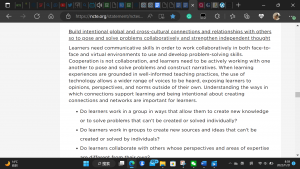
Listen to different voices to gain insights.
Students should listen to voices which come from other non-dominant communities. Collaboration prevents students from falling into cognitive bias, which are mostly caused by superficial understanding and short experiences. For example, if students have conversations with me about the public cameras, they will know that the CBS report is biased and not entirely true. Moreover, exposure to other voices enables students to earn evidence and strategies that they can use to interrupt the biased discourse.
How to teach digital literacy in secondary ELA classrooms, as well as incorporate the goals of the NCTE framework?
I would solve this problem from two routes: appreciation and creation. After all, ELA is mainly about reading and writing. I will connect digital literacy learning with the Grade 10 ELA curriculum.
I will use reliable online articles as learning resources. In this way, students engage in the networked world. When we read informational texts, we will examine the credibility and relevance of the source by looking at the author and the text’s purpose. In this way, students will not only know how to consume content but also analyze the content as well, which reach the goals of being a content consumer and making generations about specific details in literary texts at the same time.
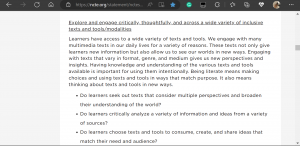
The digital consumer examines the credibility and relevancy of resources.
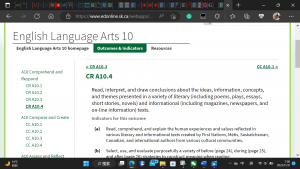
CR10.4 in Saskatchewan Curriculum.
Here is one lesson plan for the secondary ELA classroom:
- Bias in the News by Katherine Koskie
This lesson plan is about reading three online articles and finding their bias. Students will first learn the common bias in media. Then, they read three articles and identify which bias each piece has.
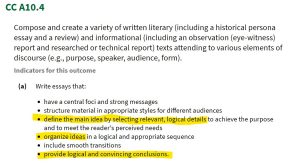
CC 10.4 Indicator A
Requirements in writing essays
I will extend this lesson plan by asking students to write an essay to explain why they think the article has bias. In this way, students can practice using evidence and logical thinking to prove something, which is an important part of writing essays in ELA.
In terms of writing, I can also assign students inquiry reports, which need them to do some online research. 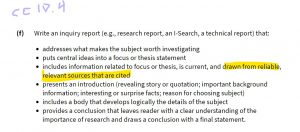 I will talk about references. Doing research is about evaluating information. Students must become effective participants who can select resources that best match their purposes. Students learn the online copyright when they learn how to reference.
I will talk about references. Doing research is about evaluating information. Students must become effective participants who can select resources that best match their purposes. Students learn the online copyright when they learn how to reference.
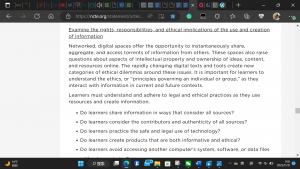
NCTE-Digital literate citizens need to respect online copyright.
Learning how to filter peer-reviewed articles gain students’ understanding of the different credibility and qualities of online resources. When doing the inquiry, students learn from and with others, which opens their horizons and breaks their cognitive bias.
Conclusion
Even adults are hard to master digital literacy because people are subjective. Teachers should first make students realize the importance of digital literacy. Suppose teachers are going to teach digital literacy in secondary ELA classrooms. In that case, they can begin by analyzing the bias in the news and then teach students how to evaluate information when studying references.
